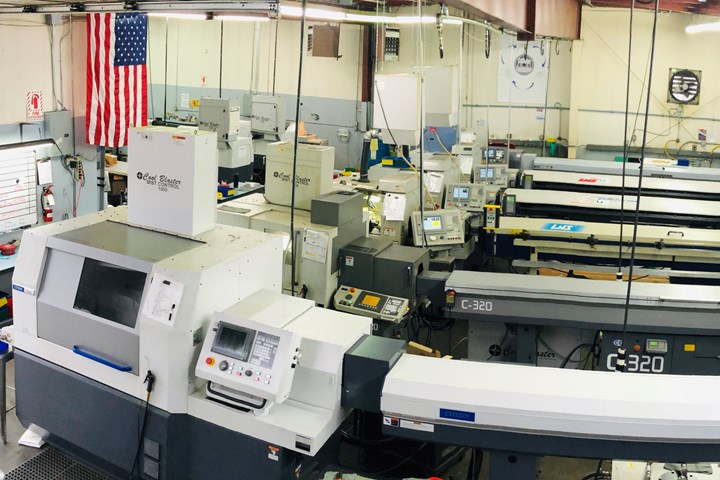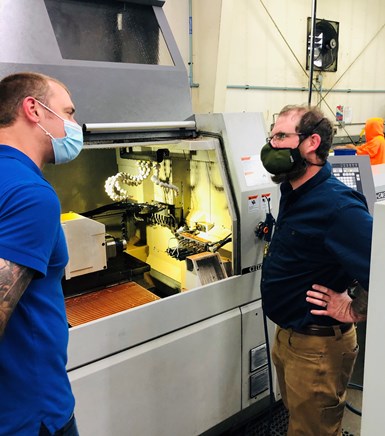Programming CNC machines by hand is not always a desirable practice. For one shop, it was a time-consuming and exhausting process that led to bottlenecks, human error, machine crashes and, inevitably, turning away lucrative business. To avoid such problems, it realized it made more sense to invest in CAM software to better serve its programming needs for its complex yet capable Swiss-type lathes.

Pacific Swiss and Manufacturing supplies precision machined parts to customers across the world. It houses nine Swiss turning centers that create parts for the medical and aerospace industries, among others. Photo credits: Pacific Swiss and Manufacturing Inc.
Previously, Pacific Swiss and Manufacturing Inc. (Portland, Oregon) did most of its programming by hand, and operators occasionally used a basic CNC editor that came with the machines. The editor was not much help, offering only minimal calculations and a cumbersome cut-and-paste program generation process.
Featured Content
“We did a lot of pen-and-paper calculations,” says Kevin Wilhite, 10-year machinist, newly minted mechanical engineer and quality engineer at Pacific Swiss. “It was grueling, to say the least. We used trial-and-error a lot of the time.”
This manual programming was a bottleneck in the shop because the machines sat idle waiting for programs. Weeklong programming sessions were followed by multiday setups and on-machine program verification. It would take about three days to set up a job, and mistakes such as a misplaced decimal point or negative sign would crash the machine, according to Scott Durkee, 20-year machine shop veteran and CNC programmer at the shop. He says machine crashes would necessitate an order for a new tool or machine repair.
Even with the talent that this shop’s operating team offers, the potential complexity of seven-axis Swiss machining on its Swiss-type lathe and the shortcomings of basic programming tools meant that they had to occasionally turn away profitable jobs that its operators deemed too complex to program by hand. It was clear an offline CAM package was needed to mitigate these issues.
The Search for Swiss Software
Pacific Swiss houses nine Swiss-types and provides specialized micro/miniature and Swiss-turned manufacturing services to the medical, dental, aerospace, and motion and flow control industries. The shop is capable of machining parts from 1.25-inch (32-mm) diameter to about 1/32-inch (0.8-mm) diameter in a variety of materials, including titanium, aluminum, stainless, copper, brass and some plastics.
With a diverse customer base and capabilities, it was critical for the shop to find CAM software with support for Swiss turning centers and turnkey postprocessors.
Wilhite says some CAM systems the company researched lacked Swiss programming and specific postprocessor solutions. Some had lackluster NC code output or user interface. However, Durkee had a great experience with Esprit software at a previous company. So he was confident that the software was the right choice for Pacific Swiss.

After integrating the Esprit software, this Oregon job shop eliminated bottlenecks in programming by saving hundreds of hours that it was taking to program machines by hand.
“Esprit is pretty easy to use,” Durkee says. “One of the things I really like is the consistency of the graphical user interface. Other programming software I’ve used would constantly change icons, menu locations and buttons. But this software has kept the interface solid.”
He adds that with each new version there are a lot of upgrades in functionality and postprocessor enhancements.
Programming and Setup
Using the latest Esprit 2020 software with SolidTurn and SolidMillTurn, Pacific Swiss quickly experienced impressive results. First, jobs that once took three days to a week to program are now usually finished in a day, including the most complex parts.

(Left to right: Scott Durkee and Kevin Wilhite) For compact and complex machines, such as the Swiss-type CNC lathes with multiple turrets and dual spindles, every movement must be extremely precise to increase productivity and avoid disasters.
“Sometimes I run into something I have never seen before, and it might take me a little while longer to figure it out, but most of that is deciding what tool and operation to use,” Durkee explains.
For compact and complex machines, such as the Swiss-type CNC lathes with multiple turret and dual spindles, every movement must be extremely precise to increase productivity and avoid disasters. And Esprit software programs concisely to live up to these expectations. At setup time, the Esprit software’s Digital Twin simulation has provided significant savings in time and tooling (see “Digital Twin Explained” below). Plus, its edit-free NC code has contributed greatly to the enhanced productivity.
“Having a solid postprocessor has eliminated a lot of those programming errors,” Durkee says. “If it works on the computer, it works on the machine.”
The confidence level that the new software’s programming offers is much higher than prior to implementing the Swiss software. The software’s capabilities even reach areas of the company such as quality control. “I don’t have to turn away a part as often because of a quality issue,” Wilhite says. “It also makes people nicer to me,” he laughs.
Hundreds of Hours Saved for One Job
The software has enhanced productivity and part quality at Pacific Swiss, with complex wrap milling, automatic chamfering cycles that eliminate secondary deburring operations and optimized spindle usage enabling the job shop to squeeze every bit of performance out of its already high-performing machines.
“The wrap contouring tool paths we generate to create outside contours to deburr parts would be very difficult to create without Esprit,” Durkee explains. “Thread-milling would be quite challenging, and any four-axis wrap pocketing would be very difficult without Esprit.”
Durkee says balancing spindle usage in legacy applications has been particularly effective. On average, the shop can reduce the cycle time by 20% on legacy programs with the software. The company runs one particular part at 30,000 pieces a year, and after programming it with Esprit, Durkee was able to get the cycle time from 3 minutes down to 2 minutes. “That’s 30,000 minutes [500 hours] of machine time saved,” he says.
“I have Esprit templates built for different machines that already have the synchronous motion of multiple axes/tools in place,” he continues. “It’s really easy to get a new part in, put the operations where I need them and have everything work simultaneously without crashes.”
Additional Advantages
Wilhite and Durkee are impressed with the customer support they receive from Esprit. Whenever Pacific Swiss has a problem or a question, Esprit is very quick to respond with an answer to the question.
With the software doing the heavy lifting, Wilhite and Durkee note the company’s prospects have widened considerably, not only by taking on more complex work but also taking advantage of its capability for planning and quoting jobs accurately.

Pacific Swiss predicts the ability to expand product lines with the help of Esprit software.
“If I’m not sure how long it will take to machine a specific feature, I’ll build a quick program with that feature and then estimate the time based on what Esprit says,” Durkee says.
All of this adds up to increased business and success. Sales last year were up 10% over 2019 when the shop was still programming manually. Sales are projected to do a lot better this year.
As for the current challenges presented by COVID-19, Wilhite is undaunted. “Business-wise, the pandemic has presented some opportunities. We’ve made some ventilator parts,” he says. “But we have had some aerospace customers push back. It’s nothing that we weren’t prepared for.”
Durkee adds that the shop has been busy and has picked up a lot of additional customers in various industries.
Looking to the future, Wilhite and Durkee see Esprit as instrumental in their future growth, not only in the complexity of work but also in equipment as the shop and its capabilities continue to expand.
“With Esprit, the transition to machines that have a programmable B-axis will be very easy, which could potentially open us to more business opportunities,” Durkee says. “The ease of programming with the software in Swiss machining gives us the competitive advantages of better product quality, reduced machining costs and improved machinability on complex parts.”
DP Technology | 800-627-8479 | espritcam.com
Pacific Swiss and Manufacturing Inc. | 503-557-9407 | pacificswissmfg.com
RELATED CONTENT
-
Winning New Jobs With Online Bidding
The digital revolution is hitting the business of the multiple-spindle automatic machining--in two distinct forms, no less. Twenty-five years after the first wave of digitization in manufacturing (numerical control) its linear descendant, computer numerical control or CNC, is changing the way screw machine shops do business.
-
CAD/CAM’s Role in How Machine Shop Benefits from its First Swiss-Type
This manufacturer of high-end RC cars leverages the capabilities of its CAD/CAM software to get the most out of its first Swiss-type lathe even when job batch sizes are relatively low.
-
From Setup to Final Pass: CNC Tool Management
With today’s high-powered and graphic-intense CNC, operators have everything under control, all on one screen.






